Blackjack Basic Strategy Card Instructions
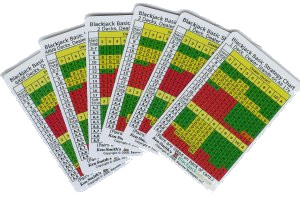
Wallet-size blackjack strategy cards tailored specifically for each set of rules. Available individually, or in a set of all six.
The full 6-card set includes:
- 1 Deck, Dealer Stands on all 17s
- 1 Deck, Dealer Hits Soft 17
- 2 Decks, Dealer Stands on all 17s
- 2 Decks, Dealer Hits Soft 17
- 4/6/8 Decks, Dealer Stands on all 17s
- 4/6/8 Decks, Dealer Hits Soft 17
- Each card features perfect basic strategy from BlackjackInfo.com
- Small credit-card sized charts for easy use at the casino table.
- Solid plastic for durability, small enough to fit in your wallet.
Also available here are the Advanced Strategy Cards, which include card counting index numbers.
Instructions:
Step 1: Choose the correct strategy card.
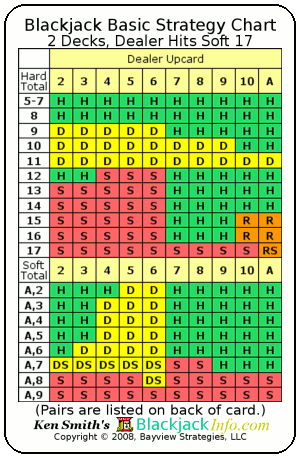
Number of Decks:
Determine how many decks are in use at the particular game you are playing. If you are not sure, just ask the dealer.
Our strategy cards come in 1 deck, 2 deck and 4/6/8 deck versions. Use the 4/6/8 deck chart for any number of decks over two. For example, some continuous shuffler games use 5 decks of cards.
Dealer Hits or Stands on Soft 17?
Some casinos offer games where the dealer must stand on all 17s, while others require the dealer to take another card if they have a “soft 17”. The tabletop felt should include wording that says either “Dealer Stands on All 17s” or “Dealer Hits Soft 17”. Use this information to choose the correct strategy card.
What is a soft 17? A “soft” hand is a hand that includes an Ace and cannot bust if you take another card. A hand of (Ace,6) is a soft 17.
A hand of (3,Ace,3) is also a soft 17. However, the hand (3,Ten,Ace,3) is not a soft 17 even though it includes an Ace.
For our example here, we’ll assume you are playing a 2 deck game, and the wording on the table indicates that the dealer hits soft 17.
Step 2: Find the row for your hand on the card.
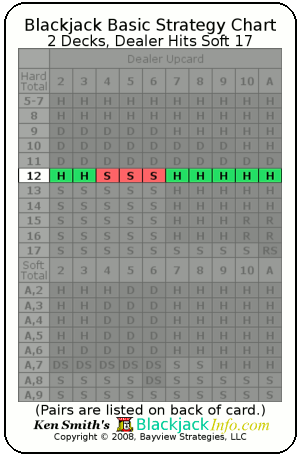
Once you’ve chosen the right strategy card, refer to it whenever you encounter a hand for which you are not sure of the best strategy. Each card is split into three major sections. On the front side of the card you’ll find sections for both hard and soft total hands that are not pairs. On the back of the card you’ll find complete advice for playing hands that are pairs.
If your two card hand is a pair of two cards of the same rank, refer to the “Pairs” section on the back of the card. If your two card hand includes an Ace, refer to the front of the card in the section “Soft Totals”. If your two-card hand does not include an Ace, find your hand total under “Hard Totals”. In each case, find the row that corresponds to your hand.
For example, let’s say you are dealt the hand (9,3) and the dealer shows a three up. Since your hand is not a pair, and it does not include an Ace, look for your total (9+3 = 12) in the Hard Totals section, as indicated here.
Step 3: Find the dealer’s upcard column.
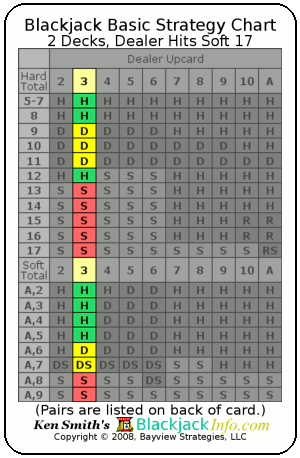
Now find the dealer’s upcard to identify which column you should use. In our example, the dealer has a three showing. Dealer upcards of Ace are shown as “A” on the cards. Dealer upcards of Ten, Jack, Queen and King are all treated as a value of ten, indicated on our charts as a ‘T’.
Our example is for the dealer having a three as the upcard.
Step 4: Locate the strategy at the intersection.
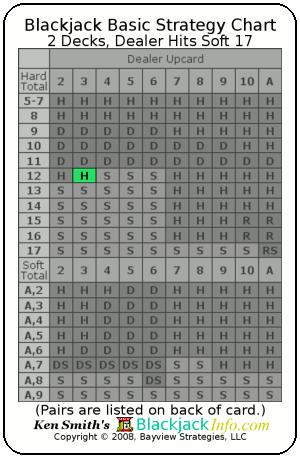
Now that you have located the appropriate row (your hand) and column (the dealer’s upcard), the appropriate strategy appears at the intersection.
For our example hand of (9,3) vs a dealer 3, that’s here:
There are many different possible values indicated on the strategy chart, so we’ll look at each possible notation:
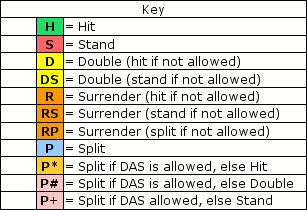
- Hit: Hit your hand (ask for another card).
- Stand: Stand and keep your current hand.
- Double: Double Down (double your original bet and receive one more card).
Note the two varieties D and DS, indicating what to do if doubling is not allowed. - Surrender: Surrender and fold your hand to receive half your bet back.
- Split: Split your two initial cards of the same rank to make two separate hands.
Note that some splits are appropriate only if Double After Splitting (DAS) is allowed.
(Recent printings of the cards have separate tables for DAS and No DAS, making this even simpler.)
Buy a set of the Basic Strategy Cards now.
Ready to take your game to the next level? Check out our Advanced Blackjack Strategy Cards, that include optimal Hi-Lo card counting index numbers right on the card.
I received my cards. I just want to be sure.
2 deck, DHS17
9 vs dealer 2 has a D and 1
this is double unless count is +1 then hit?
No, the “doubling” indexes always mean double at or above the index. So in the case of 9 vs 2 in a 2DH17 game, double if the count is +1 or higher. If the count is zero or negative, just hit.
Indexes always mean one of these three things: Stand at or above the index, double at or above the index, and split at or above the index. Which one it means varies depending on the decision. It’s a bit confusing at first. If in doubt, check the instruction pages here which show exactly when each applies. Once you get the idea, it gets easier.
You also may be confused by why basic strategy says “Double” for 9v2, yet the index is +1 for doubling. The explanation is pretty simple. Your hand includes two small cards and the dealer upcard is a small card. Therefore, off the top of a fresh shuffle, you’re already at +1, so basic strategy says double despite needing a “+1” to do so.
thank you
so keeping with the same rules as above, 9 vs 4 indicated to D (double) but has -3 which is translated to only hit at -3.
Scott
Almost. Hit when the count is worse than -3. At the index, you double.
The best way to phrase this is “double at -3 or better, else hit”.
Double at -3, -2, -1, zero, and all positive counts.
At first, this way of stating indexes and actions can seem needlessly confusing. To see why it is the standard, read this:
Learning Card Counting Indexes? Don’t Make this Mistake
Quick (and probably stupid) question:
Using your example, let’s say the correct play is to hit. When I get my new total, should I go back to the card and look up the next correct play? I.E., does this strategy refer to only the first two cards you are delt or to all new totals that come as a result of your “correct play?”
Yes, use the strategy from the card each time you need to make a decision on the hand, no matter how many cards you have.
I noticed an error when I was playing with the various combinations: I know that in a single-deck DAS H17 game with dealer peek it is correct to split 9s vs. an Ace (unlike other rule combinations where you should stand). However it shows that splitting is the right play even when changed to no-peek (which it’s obviously incorrect to split such a marginal hand with ENHC and a dealer’s Ace). (I don’t know if there are any games IRL with the single-deck DAS H17 ENHC rule combination, but since someone once pointed out an error with an even rarer rule combination with early surrender and splitting 8s vs. a Ten I thought I’d point out this one.)
Oh snap. Right you are. It only affected 1D,DAS,H17 (since that’s the only game where you should split 99vA in even a peek game!)
It’s resolved now. And for any readers, this issue wasn’t with the cards mentioned above, but instead on the Strategy Engine. Here’s the affected 1D,DAS,H17,No-Peek game: https://www.blackjackinfo.com/blackjack-basic-strategy-engine/?numdecks=1&soft17=h17&dbl=all&das=yes&surr=ns&peek=no
I mis-phrased my original comment – it was the strategy engine, not the game.
Just to clarify – I hadn’t played your actual trainer game recently so I don’t know of any bugs there (and mis-phrased probably shouldn’t have that hyphen).
Regardless, thanks for the find. Good luck.
when were the newest versions of the card corrected and printed?
January 2016. If you have cards with the error and would like them replaced, email me at [email protected]
There are likely still some of the old printing in the distribution channel.
has this error been corrected yet?
Yes, the newest versions of the card have corrected this issue.
Has this been corrected? Or will all future orders still have this issue?
The cards have not yet been reprinted, and orders will include this error for at least the next few months.
Note that the error is only in the legend, not in the charts themselves. It is still clear what the correct strategy is for each decision.
Even in the legend, it is pretty easy to see that one of the “Double” instructions should be “DS”.
I just got my basic strategy card but in the key for doubling both are listed as D with no distinguishing factor between double else hit or double else stand and only soft a soft 8 hand with a dealer 2-6 has a DS all other are D. I am wondering if I am being dumb or the card is misprinted?
It’s not you. 🙂
The most recent reprint has an error in the legend.
“DS” should say Double if allowed, else stand.
Sorry for the confusion.
Just to follow up… This error was corrected in a subsequent printing. All stock currently available at Amazon for the Basic Strategy Cards will not have this printing error.